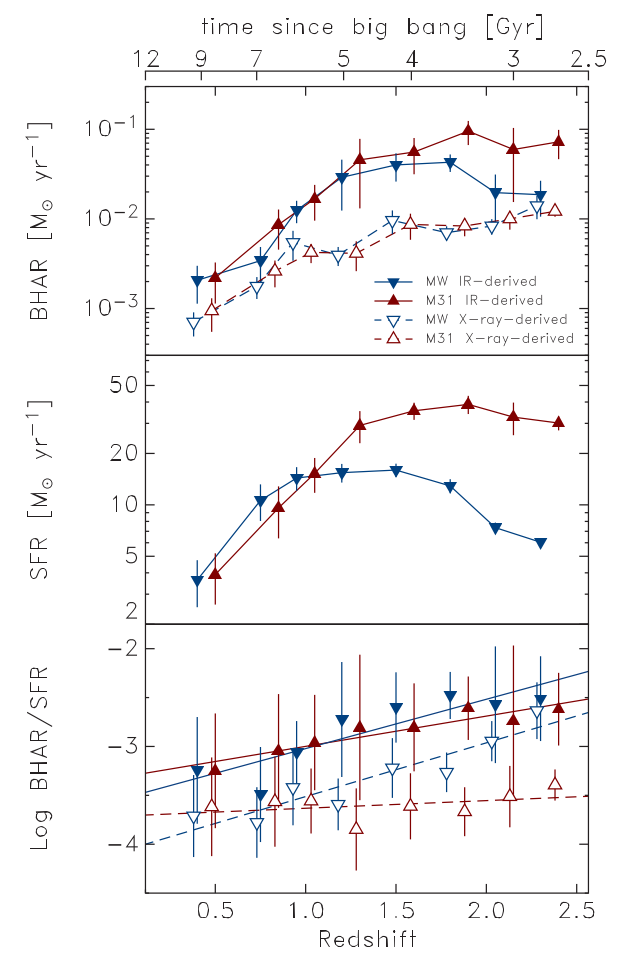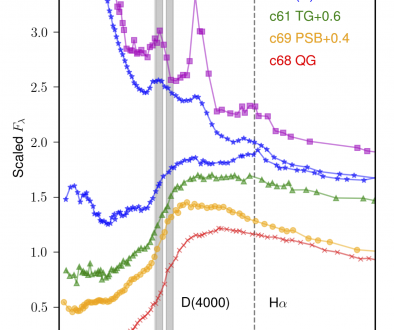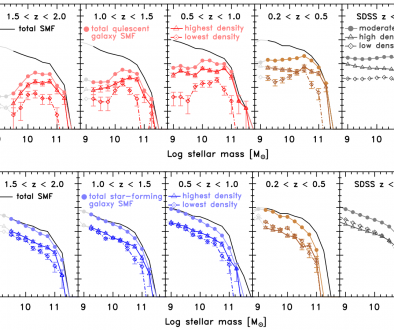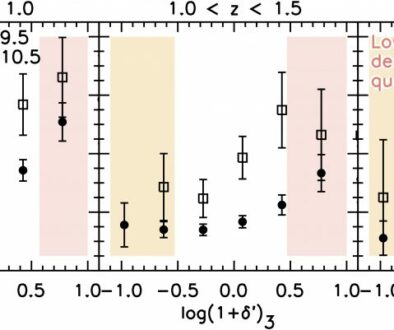Cowley 2018 Summary
We investigate the SMBH-galaxy connection by tracking the mean black hole accretion rate (BHAR) and mean star formation rate (SFR) of a sample of galaxies out to z = 2:5. We perform X-ray stacking and SED decomposition to estimate BHARs and SFRs. While such studies are prevalent, they are often limited to AGN-selected or mass-limited samples, which contain a broad mixture of galaxies with different evolutionary histories. To address this, we use the ZFOURGE catalogues to construct two independent samples based on the mass-progenitors of the present-day Milky Way (MW) and Andromeda galaxy (M31).

Top panel: The mean BHAR as a function of redshift for our MW- (blue; down triangles) and M31-mass (red; up triangles) progenitors. Vertical errors represent errors on the mean. A slight offset in redshift is applied for clarity. Middle panel: the mean SFR as a function of redshift for our progenitors (same symbols as top panel). Bottom panel: the mean BHAR to SFR ratio as a function of redshift for our progenitors (same symbols as top panel). The solid lines indicate a least-squares linear fit to these data. With the exception of the X-ray derived M31 progenitors (which are believed to be impacted by obscuration), we find an evolving BHAR/SFR ratio for the bulk of our sample. This result contrasts previous work (Calhau et al., 2017; Mullaney et al., 2012b; Dai et al., 2015), which tends to find a nearly flat BHAR/SFR ratio across cosmic time. A flat correlation is often explained by a simple scenario where a joint fuelling process regulates both SMBH growth and star formation (see Mullaney et al., 2012b).
In contrast to past work, our results show an evolutionary disconnect between the BHAR and SFR of our progenitor samples. This apparent difference illustrates the importance of selecting progenitor samples when looking for evolutionary changes in AGN. Indeed, mass-limited, star-forming or X-ray selected samples may not capture underlying evolutionary trends because they contain galaxies with very different evolutionary paths. The present work directly addresses this by adopting a selection that attempts to account for the mass growth of galaxies over the redshift range considered here.
Furthermore, we find the decline of the mean BHARs and SFRs with decreasing redshift casts doubts over the suppression of star formation being predominantly driven by luminous AGN feedback (i.e. high BHARs) in MW- and M31-mass progenitors. While one may expect to see an increase in BHARs during a period of quenching, we instead find that the rate at which the progenitors quench is decoupled from the BHARs, which decline over similar timescales.
Top panel: the evolution of the quiescent fraction for our MW- (blue; down triangles) and M31-mass (red; up triangles) progenitors as a function of redshift. We apply a slight offset in redshift for clarity. Vertical errors represent the binomial confidence interval. Bottom panel: the evolution of the quenching rate for our progenitors (same symbols as top panel). There is no evidence the evolving quenching rate is linked to the evolving BHAR.


